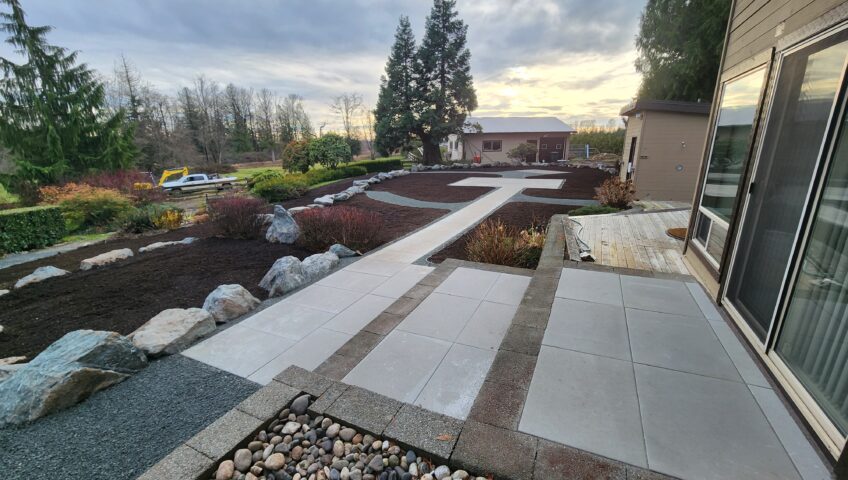Landscaping is creative practicality in action but requires proper timing to ensure flawless execution. Whether you plant a garden, install hardscaping, or redesign your entire yard, your labour will bear fruit best if you choose the right season. Choosing the right time can be the difference between a thriving outdoor space and a costly disappointment. But, what is the best time to landscape?
For landscape projects in the lower mainland, timing is essential. You should plant in the fall, leverage winter for hardscaping, nurture plants in spring, and focus on irrigation in summer. As soil in the area often becomes waterlogged or icy, consider installing proper drainage methods.
In this article, we will help you understand why timing matters for landscape projects inthe lower mainland. We will tap into expert insight and regional weather patterns for you, and expose the best times to tackle landscape projects. Pay attention to learn how to make your yard flourish year-round.
Why Timing Matters For Landscape Projects In The Lower Mainland
The lower mainland has a unique climate. It has mild, wet winters and warm, dry summers. This temperate oceanic climate is created by its proximity to the Pacific Ocean and its coastal mountains. This weather presents unique opportunities and challenges for landscape projects; if you don’t get the timing right, your yard will suffer.
To understand the complexity of the lower mainland’s climate, let’s do a brief overview of the weather conditions seen in the region:
Rainfall
Around 119 cm of rain falls on the lower mainland annually. The heaviest rainfall happens during November and December, with an average precipitation of 18.2 cm. This heavily impacts soil saturation and drainage and makes planting much harder.
Mild Winters
During winter the temperature barely falls below freezing, but some areas have wet, icy soil. Winter allows for extending planting opportunities. But you have to remain vigilant about waterlogged soil.
Dry Summers
July and August are summer months in the lower mainland. They bring dry, drought-like conditions. Without proper irrigation, your plants will not survive during this period.
Microclimates
Coastal areas like Vancouver and inland valleys like Chilliwack vary greatly in weather conditions. It’s usually colder in the Fraser Valley, and the grounds are wet, muddy, or icy. Temperature extremes and frost dates vary in each of these areas and require specialist care to survive.
As you can see, the climate conditions in the lower mainland are quite challenging. Based on the cities, or even smaller areas, soil condition, moisture, and temperature can wildly vary. Armed with this knowledge, let’s now look at what you can do in each season.
Breakdown By The Seasons: When To Landscape
Now we’ll look at the core activities you can do each season. We’ll talk in a bit more detail about each season’s climate conditions. We’ll also leave a regional tip for each season.
Fall (September-November)
Fall is the lower mainland’s landscaping sweet spot. This season offers cooler temperatures (10–15°C) and consistent rainfall. This creates ideal conditions for plants to take root without the heat stress from summer. Here are the 4 things you should do in this season:
- Tree And Shrub Planting: Species like Douglas fir, Western red cedar, and vine maple take root before winter. So it’s best to plant them now.
- Bulb Planting: Daffodils, tulips, and crocuses thrive when planted in October for spring blooms.
- Drainage Solutions: You should address soggy lawns or garden beds before winter rains intensify. Consider installing French drains or rain gardens to manage runoff.
- Lawn Care: If your yard has compacted soil, aerate it now. Overseed with cool-season grasses like fescue.
Regional Tip: In British Columbia, Fall begins to set in a bit earlier. So complete planting by mid-November or earlier to avoid heavy winter rainfall. Otherwise, rain will disrupt soil structure and wash away your seeds.
Winter (December-February)
The lower mainland has milder winters compared to other parts of Canada. Temperatures reach 37.4 – 46.4°F, but the soil becomes waterlogged and icy around Fraser Valley. These conditions call for the following 3 projects:
- Hardscaping: Concrete cures well in cool, stable temperatures. So you can install patios, retaining walls, or pathways during drier spells.
- Evergreens: You can plant hardy species like holly, boxwood, or sword fern, as they will survive the winter conditions.
- Planning: As the soil can become wet or icy, it’s the perfect time to develop and test your drainage solutions. Use this time to collaborate with landscapers for landscape projects like installing retaining walls.
Regional Tip: If the soil is waterlogged, do not work extensively on it. It will likely lead to soil compaction. Instead, focus on installing raised beds or container gardening. Also, discuss and implement appropriate drainage solutions.
Spring (March-May)
Spring in the lower mainland is cool and damp, with the last frost dates around mid-March (coastal) to early April (inland valleys). Here are 4 things you should do:
- Pruning: During summer, trim summer-blooming shrubs such as hydrangeas and deciduous trees before new growth emerges.
- Annuals And Veggies: After the last frost, you should plant frost-sensitive species like tomatoes, begonias, and basil.
- Soil Preparation: If you have clay-heavy soil, use compost or sand to improve drainage. You should also test for pH—acidic soils, as it’s common in the area. You may need construction lime for vegetable gardens.
- Pest management: Before slugs and aphids decide to visit your yard, combat them early with diatomaceous earth or companion planting such as lavender, which repels aphids.
Regional Tip: In coastal areas, you can start planting earlier. If you’re in the inland valleys, you should wait until April to avoid late frosts.
Summer (June–August)
Summer brings warm, dry weather. Temperature rises from 68°F to 77°F, which is ideal for outdoor living. However, it’s challenging for plant health. So, make these 4 decisions:
- Watering: Irrigate in the morning to combat drought stress. You can use soaker hoses or drip irrigation, which conserves water.
- Mulching: Apply bark mulch to retain moisture and suppress weeds. Make sure that you avoid piling mulch against plant stems to prevent rot.
- Container Gardening: You can use pots to plant for seasonal colours like petunias, and geraniums. Remember to relocate them to shaded areas during heatwaves.
- Lawn Care: Allow your yard’s grass to grow up to 6–8 cm. This should shade your plants’ roots and reduce water loss.
Regional Tip: Make good use of native plants like Oregon grape, salal, or yarrow. These will thrive in dry summers in the lower mainland.
As the lower mainland’s climate is temperamental, your yard’s exact conditions may differ wildly. To be truly sure of your soil condition and what landscape projects you should pay attention to, you need professional help. And you’ll get that expert help from us at New Wave Earthworks.
New Wave Earthworks: Landscape Experts In The Lower Mainland.
New Wave Earthworks is a landscaping and construction company with over 10 years of experience in landscape projects in the lower mainland. Our founders are incredibly skilled professionals and they pay attention to every small detail.
If you have landscape projects in the lower mainland, especially Chilliwack, Abbotsford, and the Tri-Cities, we are your best solution. Call us today at (604) 855-2603!
Conclusion
The lower mainland’s diverse climate conditions challenge landscape projects. But if you time it right, the soil conditions and weather turn into your allies. So, learn to make these elements work for you, and you’ll create a resilient, vibrant yard that complements the Pacific Northwest’s natural beauty.


